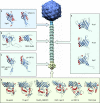A common evolutionary origin for tailed-bacteriophage functional modules and bacterial machineries
- PMID: 21885679
- PMCID: PMC3165541
- DOI: 10.1128/MMBR.00014-11
A common evolutionary origin for tailed-bacteriophage functional modules and bacterial machineries
Abstract
Bacteriophages belonging to the order Caudovirales possess a tail acting as a molecular nanomachine used during infection to recognize the host cell wall, attach to it, pierce it, and ensure the high-efficiency delivery of the genomic DNA to the host cytoplasm. In this review, we provide a comprehensive analysis of the various proteins constituting tailed bacteriophages from a structural viewpoint. To this end, we had in mind to pinpoint the resemblances within and between functional modules such as capsid/tail connectors, the tails themselves, or the tail distal host recognition devices, termed baseplates. This comparison has been extended to bacterial machineries embedded in the cell wall, for which shared molecular homology with phages has been recently revealed. This is the case for the type VI secretion system (T6SS), an inverted phage tail at the bacterial surface, or bacteriocins. Gathering all these data, we propose that a unique ancestral protein fold may have given rise to a large number of bacteriophage modules as well as to some related bacterial machinery components.
Figures




References
-
- Agirrezabala X., et al. 2007. Quasi-atomic model of bacteriophage t7 procapsid shell: insights into the structure and evolution of a basic fold. Structure 15:461–472 - PubMed
-
- Auzat I., Droge A., Weise F., Lurz R., Tavares P. 2008. Origin and function of the two major tail proteins of bacteriophage SPP1. Mol. Microbiol. 70:557–569 - PubMed
Publication types
MeSH terms
Substances
LinkOut - more resources
Full Text Sources
Other Literature Sources

